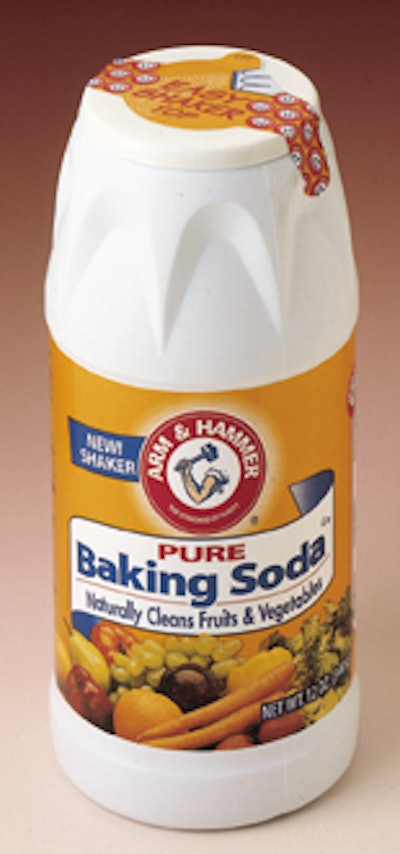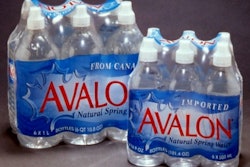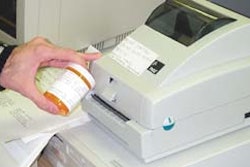When the Arm & Hammer Division of Church & Dwight, Princeton, NJ, added plastic shaker convenience to its baking soda, it also added packaging development complexity.
The convenience-driven, high-density polyethylene shaker bottle and polymeric label is a sink-side, waterproof alternative to the company’s legendary yellow box made of newsback.
For the July 2000 market introduction (see Packaging World, Nov. 2000, p. 2, or packworld.com/go/arm), Church & Dwight adapted an existing container used for Cameo, a brand of metal cleaner that the company acquired in ’98. The purchase included the molds for that product’s HDPE bottle, according to Frank Lindsay, senior manager, R&D package development for Church & Dwight.
“Not only did we feel that the bottle worked very nicely for our new product,” explains Lindsay, “but it was also an inexpensive way to get into the [plastic] bottle.”
The 3-layer bottles, containing 25% post-consumer recycled content (PCR), are molded by Silgan Plastic Containers (Chesterfield, MO) with a middle PCR layer.
Sticky details
That was the easier part of the packaging development. Much more difficult was adding an over-the-top tamper-evident band to seal the closure’s product-dispensing holes. Lindsay calls it the biggest challenge to the entire package development.
“Due to the way the product can be used, the baking soda had to be food grade,” says Lindsay. “As prescribed by law for foods, we needed a tamper-evident feature for the package.”
The company decided to use a TE label to cover the six holes in a circular pattern on the shaker top.
However, the adhesive that’s directly over the dispensing holes needed to be food grade per FDA requirements. Says Lindsay, “The number of food-grade adhesives available is very limited, and their adhesive properties are [often] poor.”
Adding complexity was the bottle design, which features arch-shaped indents around the upper perimeter, and the random application of the TE band by the applicator on the packaging production line. Combined, these factors created the need for an aggressive adhesive on the ends of the band that could grip even when applied into an indentation.
What Church & Dwight co-developed with Mail-Well Label (Englewood, CO) was a two-part label/adhesive system. A substrate with a food-grade adhesive used on the center or circular part of the label that lies over the holes fulfills FDA regulatory requirements. A more aggressive permanent adhesive on what he calls “the wings,” or flaps, provides the tamper-evidence security needed.
“We also had to pay close attention to make sure the TE label could be applied at high speed [on the production line], yet was convenient for consumers,” adds Lindsay. “It’s a very unique design, a very unique label in terms of materials and construction.”
Two-part solution
The label stock comprises two plies of pressure-sensitive film, Packaging World is told. The top ply is 3M’s (St. Paul, MN) 7779 2.6-mil white destructible vinyl with 320 adhesive. It is printed flexographically in three colors, including one custom color, yellow. The spot label underply is 2-mil clear polystyrene from 3 Sigma (Troy, OH) with DFC-107 adhesive, which is FDA approved for direct food contact. It covers only the central circular area of the label over the holes.
The labels are supplied in rolls on a 50# bleached kraft carrier.
Another detail on the band is found beneath the center edge where it’s marked “lift.” The label stock is die-cut so that when the label is removed from the liner, a tiny, half-circle piece of the liner adheres to give consumers a little area for finger pickup. The rest of the label is bonded to the HDPE closure, which is from Frescott Plastics (Brampton, Ontario, Canada).
Packaging of the product is done by Malco Products (Barberton, OH) on a newly configured line using a mix of new and reconditioned machinery. The p-s band is applied from rollstock by a new labeler from Accraply (Plymouth, MN). Prior to that, bottles are auger-filled on a 24-head system and then capped before they receive the over-the-cap label. The line operates at a rate of 120 bottles/min, Malco reports.
A wraparound label glued onto the HDPE bottle follows. Provided by Mail-Well Label, the label is made of 2-mil white polypropylene printed flexographically in seven colors and overlaminated with ½-mil clear oriented PP.
When it’s all added up, Church & Dwight solved the “hole” challenge to meet its and consumers’ needs.


























